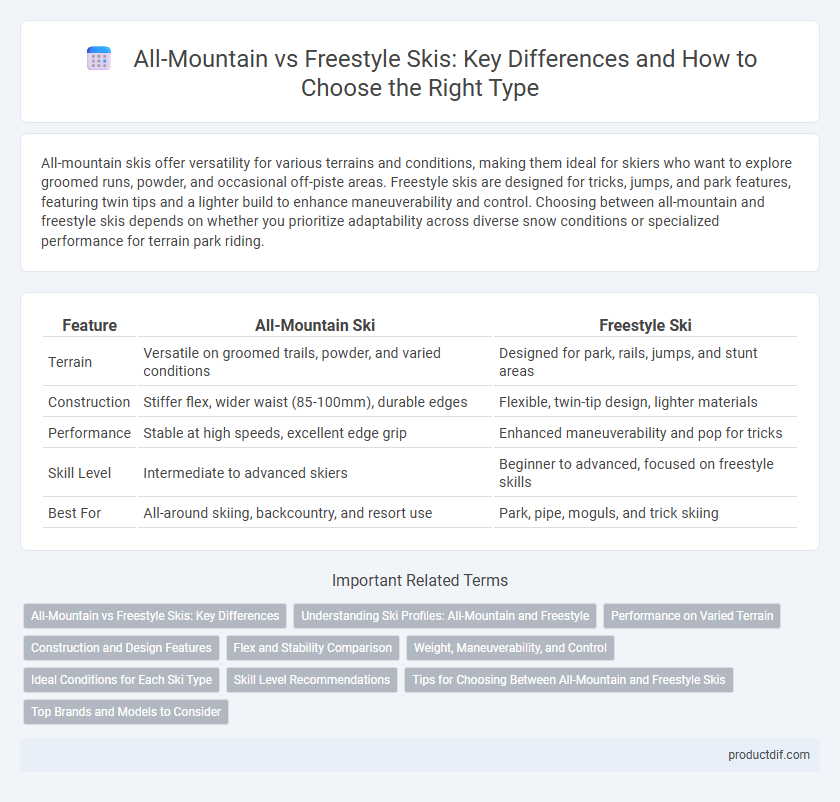All-mountain skis offer versatility for various terrains and conditions, making them ideal for skiers who want to explore groomed runs, powder, and occasional off-piste areas. Freestyle skis are designed for tricks, jumps, and park features, featuring twin tips and a lighter build to enhance maneuverability and control. Choosing between all-mountain and freestyle skis depends on whether you prioritize adaptability across diverse snow conditions or specialized performance for terrain park riding.
Table of Comparison
| Feature | All-Mountain Ski | Freestyle Ski |
|---|---|---|
| Terrain | Versatile on groomed trails, powder, and varied conditions | Designed for park, rails, jumps, and stunt areas |
| Construction | Stiffer flex, wider waist (85-100mm), durable edges | Flexible, twin-tip design, lighter materials |
| Performance | Stable at high speeds, excellent edge grip | Enhanced maneuverability and pop for tricks |
| Skill Level | Intermediate to advanced skiers | Beginner to advanced, focused on freestyle skills |
| Best For | All-around skiing, backcountry, and resort use | Park, pipe, moguls, and trick skiing |
All-Mountain vs Freestyle Skis: Key Differences
All-mountain skis are designed for versatility across varied terrains and snow conditions, featuring a medium width and stable flex for carving and powder. Freestyle skis prioritize maneuverability with a twin-tip design, softer flex, and lighter weight to enhance tricks and park performance. Choosing between all-mountain and freestyle skis depends on skiing style, with all-mountain suited for aggressive, diverse runs and freestyle optimized for jumps, rails, and tricks.
Understanding Ski Profiles: All-Mountain and Freestyle
All-mountain skis feature a versatile profile with moderate camber and rocker zones that enhance stability on groomed trails and adaptability in varied snow conditions. Freestyle skis typically have a twin-tip design with increased rocker in both tips, promoting easy maneuverability and control for jumps, tricks, and terrain park features. Understanding these profiles helps skiers choose the right equipment based on desired performance and terrain preference.
Performance on Varied Terrain
All-mountain skis offer exceptional versatility and stability, excelling on groomed runs, powder, and mixed terrains due to their balanced flex and wider waist widths. Freestyle skis prioritize maneuverability and pop with a twin-tip design, making them ideal for park features and tricks but less stable on challenging, uneven terrain. For varied terrain performance, all-mountain skis deliver superior adaptability and control, enhancing confidence across different snow conditions.
Construction and Design Features
All-mountain skis feature a versatile construction with a medium flex and a rocker-camber-rocker profile designed to perform well on various terrains and snow conditions, ensuring stability and edge control. Freestyle skis prioritize lightweight materials and twin-tip designs with softer flex, allowing for enhanced maneuverability and ease in executing tricks and jumps in park settings. The core composition of all-mountain skis often includes wood and metal layers for durability and responsiveness, whereas freestyle skis favor foam or composite cores to reduce weight and increase flexibility.
Flex and Stability Comparison
All-mountain skis feature medium to stiff flex, providing enhanced stability and control for varied terrains and high-speed carving. Freestyle skis have softer flex to enable greater maneuverability and responsiveness for tricks, jumps, and park features. The increased stability of all-mountain skis contrasts with the flexible adaptability of freestyle skis, making flex a key determinant in performance differences.
Weight, Maneuverability, and Control
All-mountain skis are designed with moderate weight to provide a balance between stability and agility, enhancing control across varied terrains, while freestyle skis feature lighter construction for superior maneuverability and quick, precise turns in park settings. The weight difference impacts rider fatigue and responsiveness, with freestyle skis favoring lightweight materials such as twin-tip designs for aerial tricks. Control in all-mountain skis is prioritized through a stiffer flex pattern and wider waist width, enabling better edge hold and versatility on groomed runs and off-piste conditions.
Ideal Conditions for Each Ski Type
All-mountain skis perform best on varied terrain, handling groomed runs, powder, and hardpack with stability and versatility. Freestyle skis excel in park conditions such as rails, jumps, and halfpipes, offering enhanced maneuverability and flexibility for tricks. Selecting the right ski depends on preferred terrain and skiing style, with all-mountain suited for diverse environments and freestyle designed for technical park features.
Skill Level Recommendations
All-mountain skis suit intermediate to advanced skiers seeking versatility across groomed trails, powder, and varied terrain, offering stability and control for diverse conditions. Freestyle skis are ideal for experienced skiers focused on park tricks, jumps, and rails, providing flexibility and durability for technical maneuvers. Beginners should start with all-mountain skis to develop foundational skills before progressing to specialized freestyle equipment.
Tips for Choosing Between All-Mountain and Freestyle Skis
Selecting between all-mountain and freestyle skis depends on terrain versatility and riding style; all-mountain skis excel in varied conditions including groomed trails and powder, offering stability and control, while freestyle skis prioritize maneuverability and lightweight design for tricks and park features. Consider ski length and flex, with all-mountain skis typically longer and stiffer for speed and stability, contrasted with shorter, more flexible freestyle skis that enhance agility. Assess your skill level and preferred skiing environment to ensure optimal performance and enjoyment on the slopes.
Top Brands and Models to Consider
Top brands for all-mountain skis include Rossignol, Salomon, and K2, offering models like Rossignol Experience 88 and Salomon QST 99, which deliver versatility and stability across varied terrains. In contrast, freestyle ski enthusiasts often favor Armada, Line, and Faction, with popular models such as Armada ARV 96 and Line Chronic designed for park performance and maneuverability. Choosing between them depends on whether riders prioritize aggressive all-terrain capability or smooth trick execution in freestyle environments.
All-mountain vs freestyle ski Infographic

 productdif.com
productdif.com